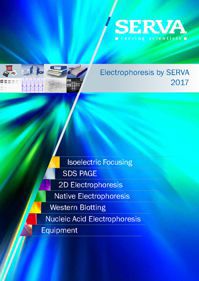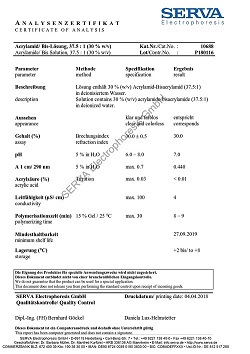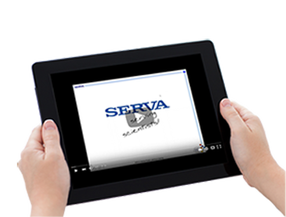Deoxycholic acid, Na-salt
Deoxycholic acid is a secondary bile acid: it is formed by metabolic conversion of cholic acid through intestinal bacteria.
Na-deoxycholate (DOC)is a good solubilizer for many membrane components and has shown to be hardly denaturing.
Na-deoxycholate exhibits good solubilizing properties for receptors like the N-methyl-D-aspartate receptor channel complex or the vitellogenin receptors.
It is also used in protein assays e.g. to eliminate the interferences that may occur in pro¬tein quantitation based on bicinchoninic acid.
A further application is in the chromatographic characterization of proteins and protein com-plexes. DOC systems have proved successful as eluting agent in the hydrophobic chromatography of phospholipase B or concanavalin A and are likewise suitable for the HPLC-detemination of HDL-apolipoproteins in serum.
Na-deoxycholate - PAGE is an excellent method for the analysis of the heterogeneity of Salmonella lipopolysaccharides, showing considerable advantages over SDS - PAGE.
Synonym: Sodium deoxycholate, DOC
CAS registry number: [302-95-4]
Molecular formula: C24H39O4 . Na
Relative molecular mass (Mr): 414.6
Classification: Anionic surfactant
Literature specification:
• Critical micellar concentration (CMC): 2.4 – 5 mM
• Aggregation number (Na): 2 – 19.9
• Critical micellar temperature (CMT): < 0 °C
• Partial specific volume (v): 0.778 cm3/g
• Hydrophilic-lipophilic balance (HLB): 16
• Acid dissociation exponent (pKa): 6.2
Bibliography
Solubilization and Characterization of Receptors
Laverdure, A.M. a. Soyez, D. (1988) Vitellogenin receptors from lobster oocyte membrane: solubilization and characterization by a solid phase binding assay. Int. J. lnvertebr. Reprod. Dev. 13, 251-66.
McKernan, R.M., Castro, S., Poat, J.A. a. Wong, E.H.F. (1989) Solubilization of the N-methyl-D-aspartate receptor channel complex from rat and porcine brain. J. Neuro¬chem.. 52, 777-85.
Protein Assays
Marshall, T. a. Williams, K.M. (1988) Turbidimetric response of aqueous protein and detergent to trichloroacetic acid. Biochem. Soc. Trans. 16, 640-1.
Brown, R.E., Jarvis, K.L. a. Hyland, K.J. (1989) Protein measurement using bicinchoninic acid: elimination of interfering substances. Anal. Biochem.180, 136-9.
Solubilization and Characterization of Phospholipids
Bayer, T.M., Werner, G.D. a. Sackmann, E. (1989) Solubilization of DMPC and DPPC vesicles by detergents below their critical micellization concentration: high-sensitivity differential scanning calorimetry, Fourier transform infrared spectroscopy and freeze-fracture electron microscopy reveal two interaction sites of detergents in vesicles. Biochim. Biophys. Acta 984, 214-24.
Malloy, R.C. a. Binford, J.S. Jr. (1990) Enthalpy titration and solubilization of dimyristoyl-phosphatidylcholine vesicles with bile salts. J. Phys. Chem. 94, 337-45.
Immunological Determination Procedures
Khristova, M.L., Busse, T.L., Egorenkova, E.M., Leonov, S.V., Sokolova, M.V., Giteiman, A.K., Herrmann, J., Doehner, L. a. Kharitonenkov, (1989) Antigenic reactivity of matrix protein and nucleoprotein of influenza virus as detected by EIA after dissociation with different detergents. Acta Virol. 33, 1-7.
Chromatographic and Electrophoretic Separations
Komuro, T.a. Galanos, C. (1988) Analysis of Salmonella lipopolysaccharides by sodium deoxycholate-polyacrylamide gel electrophoresis. J. Chromatogr. 450, 381-7.
Okazaki, M., Kinoshita, M. a. Hara, I. (1988) Improved high-performance liquid chromato-graphic method for the determination of apolipoproteins in serum high-density lipoproteins. J. Chromatogr. 430, 135-142.
Further Applications
Park, K. et al. (2006) Heparin-deoxycholic acid chemical conjugate as an anticancer drug carrier and its antitumor activity. J. Control Release 114, 300-6.
Tattersall, E.A.R. et al. (2005) Comparison of methods for isolating high-quality RNA from leaves of grapevine. Am. J. Enol. Vitic. 56, 400-6.
Morita, S. et al. (2011) Bile acid-induced expression of activation-induced cytidine deaminase during the development of Barrett`s oesophageal adenocarcinoma. Carcinogenesis 32, 1706-12.






